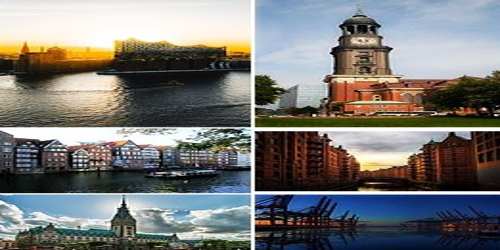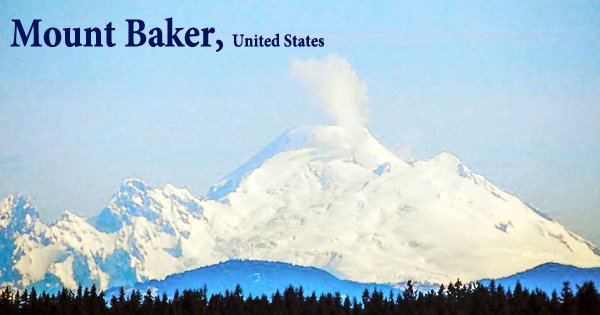Hamburg (English: /ˈhæmbɜːrɡ/, German: (ˈhambʊʁk); locally also (ˈhambʊɪ̯ç) (ˈhambɔːχ); Low Saxon: Hamborg), city and Land (state), located on the Elbe River in northern Germany. It is the country’s largest port and commercial center. Officially the Free and Hanseatic City of Hamburg (German: Freie und Hansestadt Hamburg; Low Saxon: Friee un Hansestadt Hamborg), is the second-largest city in Germany after Berlin and 7th largest city in the European Union with a population of over 1.84 million.
The Free and Hanseatic City (Freie und Hansestadt) of Hamburg is the second smallest of the 16 Länder of Germany, with a territory of only 292 square miles (755 square km). It is also the most populous city in Germany after Berlin and has one of the largest and busiest ports in Europe. The official name, which covers both the Land and the town, reflects Hamburg’s long tradition of particularism and self-government. Hamburg and Bremen (the smallest of the Länder) are, in fact, the only German city-states that still keep something of their medieval independence. The characteristic individuality of Hamburg has been proudly maintained by its people so that, in many spheres of public and private life, the city’s culture has retained its uniqueness and has not succumbed to the general trend of standardization.
Hamburg has a bit of everything; canals, pretty houses, historical architecture, interesting street art, and an amazing party scene. Believe it or not, this city has more bridges than Amsterdam and Venice combined. Housing one of the largest harbors in Europe, make sure visitors take time for a nice walk or photo shoot along one of the waterways.

This city also has Europe’s biggest red-light district – Reeperbahn. Reeperbahn is in St. Pauli, and it is the same place where the Beatles played in their early music career before they became famous all over the world. Hamburg also has the longest underwater river tunnel that goes under the Elbe River.
One of Germany’s 16 federal states, it is surrounded by Schleswig-Holstein to the north and Lower Saxony to the south. The city’s metropolitan region is home to more than five million people. Hamburg lies on the River Elbe and two of its tributaries, the River Alster and the River Bille.
The official name reflects Hamburg’s history as a member of the medieval Hanseatic League and a free imperial city of the Holy Roman Empire. Before the 1871 Unification of Germany, it was a fully sovereign city-state, and before 1919 formed a civic republic headed constitutionally by a class of hereditary grand burghers or Hanseaten. Beset by disasters such as the Great Fire of Hamburg, North Sea flood of 1962, and military conflicts including World War II bombing raids, the city has managed to recover and emerge wealthier after each catastrophe.
Hamburg, nonetheless, is a cosmopolitan city in its outlook. Although comparatively few foreigners live there, many pass through it. The city has dealings with a large number of nations, and it has more consulates than any other city in the world, except New York City. Shipping and trade have been Hamburg’s lifeblood for centuries. Not surprisingly, its harbor has remained the city’s most important feature.
In the 9th century, the location was a mission settlement to convert the Saxons to Christianity. Some centuries later, according to Hamburg’s citizens, in 1189, Holy Roman Emperor Frederick I (Emperor Barbarossa) founded the port (it was actually a medieval fraud), anyway, the city became soon the most important trading center in Europe. In the Middle Ages, the city became a member in the Hanseatic League, the commercial and defensive confederation of merchant guilds and their market towns.
Today the port of Hamburg is the third-largest port in Europe and one of Germany’s primary ports. The city is often referred to as Germany’s: “Gateway to the World”. It is one of the largest economic centers of Northern Europe.
Among Hamburg’s many other facets are a network of canals reminiscent of Amsterdam; lakes, parks, and verdant suburbs full of gracious houses; elegant shopping arcades; richly endowed museums; and vibrant cultural life. These are among the attractions that have contributed to the growing tourist industry. Although it was badly damaged during World War II, Hamburg has succeeded in maintaining a sense of old-world grace alongside its thriving commercial life.
Hamburg is a major international and domestic tourist destination. The Speicherstadt and Kontorhausviertel were declared World Heritage Sites by UNESCO in 2015. Hamburg’s rivers and canals are crossed by around 2,500 bridges, making it the city with the highest number of bridges in Europe. Aside from its rich architectural heritage, the city is also home to notable cultural venues such as the Elbphilharmonie and Laeiszhalle concert halls. It gave birth to movements like Hamburger Schule and paved the way for bands including The Beatles. Hamburg is also known for several theatres and a variety of musical shows. St. Pauli’s Reeperbahn is among the best-known European entertainment districts.
Hamburg stands at the northern extremity of the lower Elbe valley, which at that point is between 5 and 8 miles (8 and 13 km) wide. To the southeast of the old city, the Elbe divides itself into two branches, the Norderelbe and the Süderelbe, but these branches meet again opposite Altona, just west of the old city, to form the Unterelbe, which flows into the North Sea some 65 miles downstream from Hamburg. Two other rivers flow into the Elbe at Hamburg the Alster from the north and the Bille from the east.
Hamburg has an oceanic climate (Köppen: Cfb), influenced by its proximity to the coast and maritime influences that originate over the Atlantic Ocean. The location in the north of Germany provides extremes greater than typical marine climates, but definitely in the category due to the prevailing westerlies. Nearby wetlands enjoy a maritime temperate climate. The amount of snowfall has varied greatly in recent decades. The warmest months are June, July, and August, with high temperatures of 20.1 to 22.5 °C (68.2 to 72.5 °F). The coldest are December, January, and February, with low temperatures of −0.3 to 1.0 °C (31.5 to 33.8 °F).

The layout of the city –
The nucleus of the city is the Altstadt (Old Town), the former medieval settlement, bounded by the harbor and by a string of roads that follow the line of the old fortifications. Within this core, there are few great buildings to remind the visitor of the city’s thousand-year history apart from the five principal churches Sankt Jacobi, Sankt Petri, Sankt Katharinen, Sankt Nikolai, and Sankt Michaelis and none of these is in its original condition. Fire has destroyed almost all the older residences and warehouses, and what was left untouched by conflagration has often been rebuilt for contemporary purposes. There are, however, a few scattered survivals of older buildings. Moreover, the layout of the old city center can still be detected in some of the ancient street names and in the Fleete (canals), which connect the Alster with the docks on the Elbe. One of the best views of the inner city is to be enjoyed from the Lombardsbrücke (Lombard Bridge), whence the towers of the five churches can be seen rising high against a skyline that is still relatively harmonious despite the presence of modern skyscrapers.
At the heart of Hamburg is a lake, measuring 455 acres (184 hectares), formed by the damming of the Alster and divided by the Lombardsbrücke into the Binnenalster (Inner Alster) and the Aussenalster (Outer Alster). Around the latter are elegant suburbs such as Rotherbaum, Harvesterhude, and Uhlenhorst. Many waterways, navigable by pleasure boats, run into the Aussenalster.
Architecture and Sights of the city –
The name Hamburg comes from the first permanent building on the site, a castle which Emperor Charlemagne ordered constructed in AD 808. It rose on rocky terrain in a marsh between the River Alster and the River Elbe as a defense against Slavic incursion and acquired the name Hammaburg, burg meaning castle or fort. The origin of the Hamma term remains uncertain, as does the exact location of the castle.

The last intact ensemble of traditional Hamburg architecture is to be found in the Deichstrasse, one side of which backs onto the Nikolai canal. Its tall, narrow houses, resembling those of Amsterdam, were originally built from the 17th through the 19th century. It was in one of them, number 42, now a restaurant, that the devastating fire of 1842 broke out. Afterward, the houses were rebuilt in the old style. Today the street is a protected area, and in recent years it has undergone extensive restoration. Many traditional restaurants are found there.
Another survival of older architecture is in the Krameramtswohnungen, near Sankt Michaelis. Consisting of two half-timbered brick buildings on either side of a narrow courtyard, it was built as a series of dwellings for the widows of shopkeepers and is the only surviving 17th-century construction of its kind in the city. Thoroughly restored between 1971 and 1974, it now forms a delightfully secluded alleyway housing a restaurant, small shops, and a branch of the Museum für Hamburgische Geschichte (Museum of Hamburg History).
Of Hamburg’s five great churches, the most imposing is probably Sankt Michaelis, an 18th-century Baroque-style Protestant church with a rich white-and-gold interior. It was destroyed by fire in 1906, rebuilt, devastated again during World War II, and restored yet again after the war.
The prosperous years 1890–1910 brought an abundance of fine architecture, examples of which can be seen in the spacious and elegant patrician houses around the Aussenalster. Many of these are now occupied by consulates. Another period of architectural flowering came in the 1920s and 1930s when there was a revival of the use of the traditional north German dark red brick as a building material, led by the architect’s Fritz Höger and Fritz Schumacher. A good example is Höger’s Chilehaus, a massive office building constructed between 1922 and 1924.
More recently Hamburg has acquired its quota of starkly functional modern buildings, such as the Congress Centrum (Congress Centre; opened 1973) and the Fernsehturm (Television Tower), 271.5 meters (891 feet) high, but there is now a strong tendency to renovate old houses rather than to demolish and build afresh. Thus the townscape of Hamburg as a whole has a human quality lacking in many German cities.
The Reeperbahn in the heart of the city, a street and a famous entertainment and red-light district with a long history. Kunsthalle Hamburg, a large art museum, its collections cover more than seven centuries of European art. Elbphilharmonie, the city’s new philharmonics and one of the largest and most acoustically advanced concert halls in the world. Internationales Maritimes Museum in the HafenCity, meet the history of ships and sea navigation.
Deichtorhallen, the two former market halls from the beginning of the 20th century are today one of the largest exhibition halls for contemporary art and photography in Europe. The century-old Speicherstadt, the world’s largest contiguous used warehouse complex, Speicherstadt, and Kontorhaus are a UNESCO World Heritage Site.
Jungfernstieg, the city’s famous boulevard along Binnenalster, in 1838 Jungfernstieg became Germany’s first street to be asphalt paved. Außenalster, and Binnenalster, two artificial city lakes used for recreation.
Port of Hamburg, if any visitors like ports, this is the place to be, around 9,000 ship calls per year, almost 300 berths, and a total of 43 kilometers of quay for seagoing vessels. Fans of model railways will be in heaven at Miniatur Wunderland (Miniature Wonderland), the largest of its kind in the world.
The Emigration Museum documents the story of the millions of European emigrants who are about to start their journey to the New World 120 years ago.
Planten un Blomen (plants and flowers), an inner-city urban park with occasional water-light concerts, public theater, and music performances, within the park is also the Old Botanical Garden of Hamburg.
Tierpark Hagenbeck is Hamburg’s zoo, founded by a fishmonger in the beginning of the 20th century, it was the first zoo in the world to use open enclosures surrounded by moats to present the animals to the public.

The Economy (Industry and Trade) –
Having absorbed Altona, Harburg, and Wandsbek in 1937, Hamburg has become Germany’s major industrial city. All processing and manufacturing industries are represented there. Hamburg treats most of the country’s copper supplies, and the Norddeutsche Affinerie, on Veddel, is Europe’s second-largest copperworks. The chemical, steel, and shipbuilding industries are also important, although shipbuilding has declined as a result of competition from Japan and Korea. Hamburg is also the most important center in Germany, after Berlin, for newspaper and periodical publishing. Nuclear plants at Krümmel and Brunsbüttel provide power at a reasonable cost to the industries bordering the Unterelbe and to parts of Hamburg.
In the period of German partition, Hamburg handled more than half of West Germany’s foreign trade, not only in the form of shipping cargo but also as rail and airfreight. Chief among imports are vegetable oils and fats, tea, coffee, petroleum, tropical fruit, and uncured tobacco. Exports include machinery, electrotechnical products, processed petroleum fuel and lubricants, copper, and pharmaceutical products.
The greatest economic center of Germany, Hamburg since 1960 has become the site of first-class trade fairs. Many of the fairs and conventions are held at the Ernst-Merck-Halle exhibition grounds, located south of the Planten un Blomen park. An especially popular event is the international boat show, held each winter.
Tourism –
In 2017, more than 6,783,000 visitors with 13,822,000 overnight stays visited the city. The tourism sector employs more than 175,000 people full-time and brings in a revenue of almost €9 billion, making the tourism industry a major economic force in the Hamburg Metropolitan Region. Hamburg has one of the fastest-growing tourism industries in Germany. From 2001 to 2007, the overnight stays in the city increased by 55.2% (Berlin +52.7%, Mecklenburg-Vorpommern +33%).
Foodies will appreciate the increase in multicultural eateries, and visitors can’t miss a chance to stop by the Hamburger Fischmarkt, the local fish market right near the Elbe River. Every Sunday morning from 7 am–9:30 am, join thousands of other visitors as they barter for fish and shop for just about anything else they could need; from souvenirs to flowers to fruit, they have it all!
Navigating Hamburg is super easy as visitors will have access to a light-rail network, underground trains, buses, and even ferries. The best part of Hamburg’s buses have bookshelves and visitors can borrow books for free!
Hamburg’s cherished traditions, together with its thriving business and cultural life and the energy of its inhabitants, make it one of the most vibrant cities in the world.
Information Sources:
















